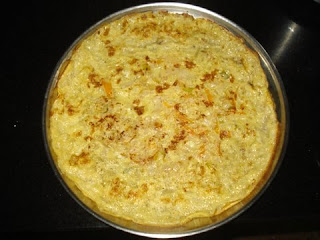Rice and Shine!
I realized that I have been neglecting this blog for a long time. Forgive me for that, but I return not empty-handed. A bit of a news first. I wrote two recipes for the college magazine. I will post them here once the magazine gets published. Until then, I present to you "The Humble Rice".
Comprised primarily of starch and fiber, rice is a source of vitamins B1 and B2 and minerals like potassium and phosphorous also, while being low in sodium content. The carbohydrates in rice are digested slowly, which allows for the body to utilize the energy over a longer time. Rice contains only traces of fat and absolutely no cholesterol, making it an extremely healthy food.
Rice is a staple food in India and most of the eastern nations, with each nation having its typical dishes made from rice. The variety of dishes that can be made with rice is astounding. These grains can be used in any course of the meal, be it appetizer or soup or entrée or a side or dessert. It can be had for breakfast or lunch, evening snacks or for dinner. While the West likes its Risotto with short-grained Arborio rice, Paella with medium-grained Bomba and Pilafs with long-grained rice, the Far East prefers its sticky(-ier (?)) rice in Sushi rolls and as Stir-Fried Rice or steamed rice and a bit soup-like as congee.
Even within India, the preferences of the populace varies widely. The North, typically, prefers wheat over rice with the rice eaters opting for seasoned rice dishes over plain rice. The South, predominantly, opts for plain steamed rice and has it with a wide variety of stews, sambhar, rasam, pappus, pachdis, podis and what not, everything washed down with a dollop of cooling curd rice. The omnipresent rice dishes of India, though, would have to be the Royal Biryanis and Pulaos made with the patented Basmati rice. As I pointed out, rather dramatically, at my other blog, the former is layered and the latter is stirred.
The main problem people face with beginning to cook rice is to get it to the proper consistency. So here are my tips:
Even within India, the preferences of the populace varies widely. The North, typically, prefers wheat over rice with the rice eaters opting for seasoned rice dishes over plain rice. The South, predominantly, opts for plain steamed rice and has it with a wide variety of stews, sambhar, rasam, pappus, pachdis, podis and what not, everything washed down with a dollop of cooling curd rice. The omnipresent rice dishes of India, though, would have to be the Royal Biryanis and Pulaos made with the patented Basmati rice. As I pointed out, rather dramatically, at my other blog, the former is layered and the latter is stirred.
The main problem people face with beginning to cook rice is to get it to the proper consistency. So here are my tips:
- Always wash the rice before cooking to remove excess starch from the surface. Any surface starch will make the cooked rice gummy and sticky. If necessary, depending on the freshness of the rice, soak the rice in cold water.
- As a general rule, use 2 cups of water for a cup of long-grained white rice. Brown rices require more water. Shorter-grained rice require less water. More water gives softer, stickier rice - which is great for stir-fries, while less water results in firmer rice - good for rice salads.
- Use a heavy-bottomed vessel to cook the rice in. This will result in lesser scorching at the bottom, through greater dissipation of heat.
- Also, use a tight lid to trap the steam in. This is essential, since the water level keeps decreasing as more and more water is converted to steam. The rice at the top is cooked by the steam and the rice at the bottom is cooked by the boiling water.
- After all the moisture is absorbed, i.e. the cooking is finished, remove the vessel and keep undisturbed for at least 5 minutes and up to 30 minutes so that the moisture is redistributed evenly among the rice grains.
The result: fluffy, perfect rice. Well, eventually. It does take a few trials to get it right, to get the feel of the rice variety you use, your cooking vessel and the heat levels of your stove.


@ whitelighter
ReplyDeleteIts true, I always use the last point - well, okay, my mom does. But it works.
You know, most people don't like sticky brown rice, at leats in India, and prefer the fine white rice of the Basmati variety instead. But I love brown rice, somehow. And in fact, in Singapore, that's the only variety of rice they serve.
@ whitelighter
ReplyDeleteAnyway, congrats on getting your articles selected. I tried to search the magazine site for your articles, but they don't seem to have been published yet.
One brown rice recipe that I know is the preparation of the south Indian Sweet Pongal.
ReplyDeleteThe magazine hasn't been published yet. That is why I haven't posted the recipes here till now. Will put those recipes online once the magazine is released.